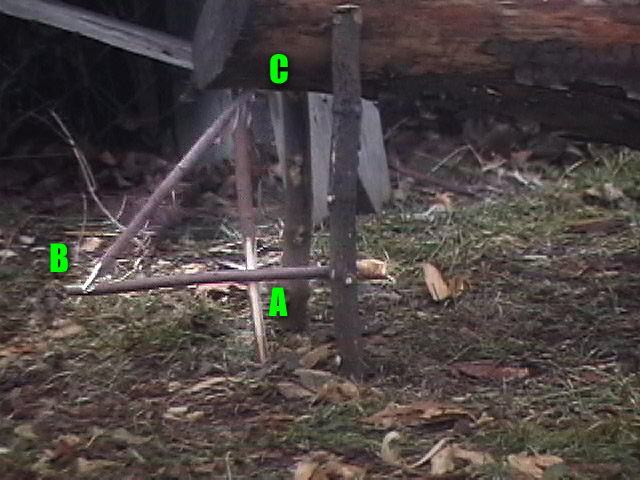How to: Make The Figure-4 Dead-Fall Trap
Video
This is one of the easiest basic mechanical traps to learn and construct, provided you have a cutting edge such as a rock or knife. It uses a weight as a dead-fall to pin or kill your quarry. 
- A rock or other weight rests on the end of the diagonal stick. This supplies downward pressure to the end of that stick. If you use a round dead-fall like a log you may have to create guide posts on either side to keep it from rolling and not setting properly.
- The diagonal stick rests on and pivots on the vertical stick at "C". This keeps the diagonal stick from slipping away to the left.
- The diagonal stick is also held in place by having the end rest in a notch at "B".
- The pressure of the diagonal stick is pulling the horizontal stick towards the left.
- The horizontal stick is held in place by the notches at "A".
- "A" is where the actual trigger mechanism is located.
- The bait is placed at the end of the horizontal stick to the right of "A" (this stick can be made longer as necessary), so that it is located directly under the weight.
- When the animal takes the bait at the end of the horizontal stick, the trigger at "A" is released. The horizontal stick falls to the ground, and the diagonal stick flips up and out in an arc. This allows the weight to come crashing down on the quarry.
- Note that the vertical stick should be resting on a hard surface, such as a flat stone. Otherwise it may dig into the ground and cannot fall out of the way when the trap is triggered - the deadfall weight will come to rest on the vertical stick and won't fall to the ground.
- Note also that it is usually good practice to put something hard on the ground under the whole trap, or place the trap on rock. Otherwise, the deadfall, when it falls, may not kill the animal, only injure it, since the animal may be pressed into the soft ground.
Figur-4s can also be constructed without a cutting edge. Knots or natrual bends in the sticks used can create the mechanism necessary for the trap to work.
NOTE: In a serious survival situation setting traps for anything smaller than a chipmunk may not be worth the caloric effort of setting up the trap.

Click to download diagram >>
WARNING: Most primitive traps are illegal to use in most states. Unless under a life-or-death survival situation it is not recommended that you use them.
SORRY - There are no steps for this How-To. Please check back later. Or drop me a line at TheUrbanAbo@gmail.com to let me know you wanna see this one fleshed out.







